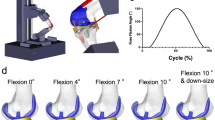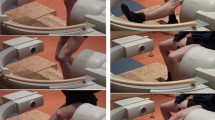Abstract
The objective of this study was to investigate biomechanics of TKA patients during high flexion. Six patients (seven knees) with a posterior-substituting TKA and weight-bearing flexion >130° were included in the study. The six degree-of-freedom kinematics, tibiofemoral contact, and cam-post contact were measured during a deep knee bend using dual-plane fluoroscopy. The patients achieved average weight-bearing flexion of 139.5 ± 4.5°. Posterior femoral translation and internal tibial rotation increased steadily beyond 90° flexion, and a sharp increase in varus rotation was noted at maximum flexion. Initial cam-post engagement was observed at 100.3 ± 6.7° flexion. Five knees had cam-post disengagement before maximum flexion. Lateral femoral condylar lift-off was found in five out of seven knees at maximum flexion, and medial condylar lift-off was found in one knee. Future studies should investigate if the kinematic characteristics of posterior-substituting TKA knees noted in this study are causative factors of high knee flexion.




Similar content being viewed by others
References
Andriacchi TP, Dyrby CO, Johnson TS (2003) The use of functional analysis in evaluating knee kinematics. Clin Orthop Relat Res 410:44–53
Bellemans J, Banks S, Victor J, Vandenneucker H, Moemans A (2002) Fluoroscopic analysis of the kinematics of deep flexion in total knee arthroplasty. Influence of posterior condylar offset. J Bone Jt Surg Br 84:50–53
Chandran N, Amirouche F, Gonzalez MH, Hilton KM, Barmada R, Goldstein W (2008) Optimisation of the posterior stabilised tibial post for greater femoral rollback after total knee arthroplasty—a finite element analysis. Int Orthop [Epub ahead of print]
Coughlin KM, Incavo SJ, Doohen RR, Gamada K, Banks S, Beynnon BD (2007) Kneeling kinematics after total knee arthroplasty: anterior-posterior contact position of a standard and a high-flex tibial insert design. J Arthroplast 22:160–165
Delport HP, Banks SA, De Schepper J, Bellemans J (2006) A kinematic comparison of fixed- and mobile-bearing knee replacements. J Bone Jt Surg Br 88:1016–1021
Dennis DA, Komistek RD, Scuderi GR, Zingde S (2007) Factors affecting flexion after total knee arthroplasty. Clin Orthop Relat Res 464:53–60
Dennis DA, Komistek RD, Walker SA, Cheal EJ, Stiehl JB (2001) Femoral condylar lift-off in vivo in total knee arthroplasty. J Bone Jt Surg Br 83:33–39
Hamai S, Miura H, Higaki H, Matsuda S, Shimoto T, Sasaki K, Yoshizumi M, Okazaki K, Tsukamoto N, Iwamoto Y (2008) Kinematic analysis of kneeling in cruciate-retaining and posterior-stabilized total knee arthroplasties. J Orthop Res 26:435–442
Han HS, Kang SB, Yoon KS (2007) High incidence of loosening of the femoral component in legacy posterior stabilised-flex total knee replacement. J Bone Jt Surg Br 89:1457–1461
Hanson GR, Park SE, Suggs JF, Moynihan AL, Nha KW, Freiberg AA, Li G (2007) In vivo kneeling biomechanics after posterior stabilized total knee arthroplasty. J Orthop Sci 12:476–483
Hanson GR, Suggs JF, Freiberg AA, Durbhakula S, Li G (2006) Investigation of in vivo 6DOF total knee arthoplasty kinematics using a dual orthogonal fluoroscopic system. J Orthop Res 24:974–981
Hemmerich A, Brown H, Smith S, Marthandam SS, Wyss UP (2006) Hip, knee, and ankle kinematics of high range of motion activities of daily living. J Orthop Res 24:770–781
Jennings LM, Bell CJ, Ingham E, Komistek RD, Stone MH, Fisher J (2007) The influence of femoral condylar lift-off on the wear of artificial knee joints. Proc Inst Mech Eng [H] 221:305–314
Kim TH, Lee DH, Bin SI (2008) The NexGen LPS-flex to the knee prosthesis at a minimum of three years. J Bone Jt Surg Br 90:1304–1310
Lee SY, Matsui N, Kurosaka M, Komistek RD, Mahfouz M, Dennis DA et al (2005) A posterior-stabilized total knee arthroplasty shows condylar lift-off during deep knee bends. Clin Orthop Relat Res 435:181–184
Li G, Most E, Otterberg E, Sabbag K, Zayontz S, Johnson T et al (2002) Biomechanics of posterior-substituting total knee arthroplasty: an in vitro study. Clin Orthop Relat Res 404:214–225
Li G, Most E, Sultan PG, Schule S, Zayontz S, Park SE, Rubash HE (2004) Knee kinematics with a high-flexion posterior stabilized total knee prosthesis: an in vitro robotic experimental investigation. J Bone Jt Surg Am 86:1721–1729
Li G, Papannagari R, Li M, Bingham J, Nha KW, Allred D et al (2007) Effect of posterior cruciate ligament deficiency on in vivo translation and rotation of the knee during weightbearing flexion. Am J Sports Med 36:474–479
Li G, Suggs J, Hanson G, Durbhakula S, Johnson T, Freiberg A (2006) Three-dimensional tibiofemoral articular contact kinematics of a cruciate-retaining total knee arthroplasty. J Bone Jt Surg Am 88:395–402
Mulholland SJ, Wyss UP (2001) Activities of daily living in non-Western cultures: range of motion requirements for hip and knee joint implants. Int J Rehabil Res 24:191–198
Ng FY, Wong HL, Yau WP, Chiu KY, Tang WM (2008) Comparison of range of motion after standard and high-flexion posterior stabilised total knee replacement. Int Orthop 32:795–798
Park KK, Shin KS, Chang CB, Kim SJ, Kim TK (2007) Functional disabilities and issues of concern in female Asian patients before TKA. Clin Orthop Relat Res 461:143–152
Scuderi GR, Komistek RD, Dennis DA, Insall JN (2003) The impact of femoral component rotational alignment on condylar lift-off. Clin Orthop Relat Res 410:148–154
Suggs JF (2007) Investigation of in-vivo total knee arthroplasty biomechanics using a dual fluoroscopic imaging system. Dissertation, Massachusetts Institute of Technology, Cambridge, MA
Suggs JF, Hanson GR, Park SE, Moynihan AL, Li G (2008) Patient function after a posterior stabilizing total knee arthroplasty: cam-post engagement and knee kinematics. Knee Surg Sports Traumatol Arthrosc 16:290–296
Acknowledgement
This work was supported by a research grant from Zimmer Inc., Warsaw, IN, USA.
Conflict of interest
One of the coauthors is an employee of Zimmer, Inc. None of the coauthors received any benefits for this work.
Author information
Authors and Affiliations
Corresponding author
Electronic supplementary material
Below is the link to the electronic supplementary material.
Figure A1
Individual patient translations posteriorly (a) and proximally (b) throughout flexion (GIF 79 kb)
Figure A2
Individual patient internal rotation (a) and varus rotation (b) throughout flexion (GIF 67 kb)
Figure A3
Medial compartment contact location for each knee throughout flexion in the anteriorposterior direction (a) and in the medial-lateral direction (b) (GIF 75 kb)
Figure A4
Lateral compartment contact location for each knee throughout flexion in the anteriorposterior direction (a) and in the medial-lateral direction (b) (GIF 86 kb)
Figure A5
Maximum flexion position for each patient knee where contact and condylar lift-off can be seen. Cam-post contact locations and incidences of slight contact are also shown and circled (GIF 148 kb)
Rights and permissions
About this article
Cite this article
Moynihan, A.L., Varadarajan, K.M., Hanson, G.R. et al. In vivo knee kinematics during high flexion after a posterior-substituting total knee arthroplasty. International Orthopaedics (SICOT) 34, 497–503 (2010). https://doi.org/10.1007/s00264-009-0777-2
Received:
Revised:
Accepted:
Published:
Issue Date:
DOI: https://doi.org/10.1007/s00264-009-0777-2




